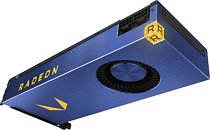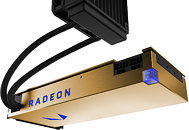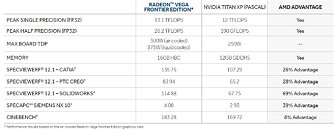Friday, June 16th 2017

AMD Radeon Pro Vega Frontier Edition TDP and Pricing Revealed
AMD Radeon Pro Vega Frontier Edition goes on sale later this month (26 June). It is designed to provide a "gateway" to the "Vega" GPU architecture for graphics professionals and game developers alike, with the consumer graphics product, the Radeon RX Vega, is bound for late-July/early-August. Radeon Pro Vega Frontier Edition, being a somewhat "enterprise-segment" product, was expected to have slightly lower TDP than its consumer-graphics sibling, since enterprise-segment implementations of popular GPUs tend to have slightly restrained clock speeds. Apparently, AMD either didn't clock the Radeon Pro Vega Frontier Edition low, or the chip has extremely high TDP.
According to specifications put out by EXXACT, a retailer which deals with enterprise hardware, the air-cooled variant of the Radeon Pro Vega Frontier Edition has a TDP rated at 300W, while its liquid-cooled variant has its TDP rated as high as 375W. To put this in perspective, the consumer-segment TITAN Xp by NVIDIA has its TDP rated at 275W. EXXACT is claiming big performance advantages in certain enterprise benchmarks such as SPECVIEWPERF and Cinebench. In other news, the air-cooled Radeon Pro Vega Frontier Edition is reportedly priced at USD $1,199; while the liquid-cooled variant is priced at $1,799. Based on the 14 nm "Vega 10" silicon, the Pro Vega Frontier Edition features 4,096 stream processors and 16 GB of HBM2 memory across a 2048-bit memory interface.
According to specifications put out by EXXACT, a retailer which deals with enterprise hardware, the air-cooled variant of the Radeon Pro Vega Frontier Edition has a TDP rated at 300W, while its liquid-cooled variant has its TDP rated as high as 375W. To put this in perspective, the consumer-segment TITAN Xp by NVIDIA has its TDP rated at 275W. EXXACT is claiming big performance advantages in certain enterprise benchmarks such as SPECVIEWPERF and Cinebench. In other news, the air-cooled Radeon Pro Vega Frontier Edition is reportedly priced at USD $1,199; while the liquid-cooled variant is priced at $1,799. Based on the 14 nm "Vega 10" silicon, the Pro Vega Frontier Edition features 4,096 stream processors and 16 GB of HBM2 memory across a 2048-bit memory interface.



123 Comments on AMD Radeon Pro Vega Frontier Edition TDP and Pricing Revealed
My thought is that they are binned like anything else. Just needs to hit X clocks with X voltage and power use and it fits a bin. Some have headroom some don't. I don't know. I never saw it, honestly and why I am asking. :)
Anyway, as AMD seems to understand, the real money is to be made in the mainstream category, not the top-end gaming. That's why they don't upgrade the flagship cards very often and the top RX card is somewhere in the middle of NVIDIA offer.
It's over a year since the launch of Pascal, Pascal is now past midway in its life cycle, and AMD is still struggling to prepare its competitor. GV104 will arrive early next year, while Navi is pushed to the end of 2018…
AMD should have dropped HBM so they at least could have mass produced their chips. They need to compete with GTX 1080, GTX 1070 and GTX 1060, that's where the revenue is. Perhaps even put a model between GTX 1060 and GTX 1070, since there is a huge performance and price gap there.
However, in general power consumption is not just money.
These cards will land not only in RACK servers, but also in desktop workstations designed for office infrastructure. As such, it is important how much energy they draw (because there's a limit) and how much heat/noise they produce (obvious).
A TDP of 375W is beyond anything we've seen lately and the FP16 performance is just slightly better than Pascal's (TDP=250W).
Here, enjoy some nice numbers from computerbase.de:
The difference between 1060 FE and RX 580 in idle is 4 Watts. The difference at gaming is 77 Watts. The difference in Youtube video is 2 Watts. If you leave the RX 580 idling with monitor off, it can turn off into ZeroCore Power modus which consumes virtually no power, but I'm putting 1 W there just to be fair. Both cards perform virtually identical in games.
If you leave the computer running 24/7 and it idles 12 hours, you game 6 hours, watch a Youtube for 2 hours and do other things non graphical intensive things for 4 hours the 1060 FE will consume: (12h*7W + 6h*111W + 2h*29W+4h*7W)/24h = 35W per hour and the RX 580 will consume (12h*1W + 6h*188W + 2h*31W+4h*11W)/24h = 50W per hour.
15 Watts/hour difference. Better have a fire extinguisher near your RX 580 system or it might catch fire! /s
I can't see anyone buying Vega over Pascal for FP32.
AMD can't really compete when their contender consumes 185W and the competition consumes 120W, their competition becomes the superior choice here. Energy consumption matters because of heat and noise. AMD needs comparable efficiency to become relevant again.
With Vega FE with a (claimed) TDP of 300W, and the comparable product Quadro GP100 with a TDP of 235W, it becomes clear that Vega will struggle to compete. In the professional market they probably can sell a few by selling them a bit cheaper, but in the consumer market the margins are a lot smaller.
As for RX Vega: when the card comes out and if its noisier, hotter and consumes 15 Watts/hour more per my calculation vs. 1080Ti FE then you won and AMD messed up. Happy now?
Isn't $1,700 for 20%(ish) more flops a much more attractive prospect than $6,000 for GP100 regardless of heat or noise unless those are absolutely critical issues?
Don't worry if you are an über-pro, AMD will make a wx vega or something as well probably that's more suited for quadro style applications at some point and for servers there will be the MI25.Depends really. Wx7100 and p4000 get close to or beat vega frontier air-cooled in specviewperf, so depending on your applucations it can be better or worse than 6000 dollar nvidia gpu's. How pro are you?
Don't worry if you are an über-pro, AMD will make a wx vega or something as well probably that's more suited for quadro style applications at some point and for servers there will be the MI25 accelerator.
I hope they manage to get Vega out the door sometime soon. I don't think they can afford more delays in the high end GPU segment and they need something new to trickle down across the range.
It's a bit to early to say how well built and spec'd this new Radeon Pro Vega FE is going to be, but the pricing suggests it'll just be an expensive consumer/workstation model, not a calculation workhorse. Just by raw numbers we see in specification, it is going to outperform AMD's own Pro alternatives costing over twice as much.
Plus, NVIDIA can always ask more because of CUDA...
I've never seen a product incorporate OC headroom inside their TDP, and certainly not a professional product. If the final TDP really is 300/375 W, then the actual max consumption + a smal safety margin will equal this number, as with every previous product.
BTW: NVIDIA is doing way more things than AMD. And they're making a profit. A lot of it.